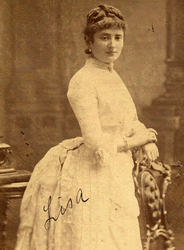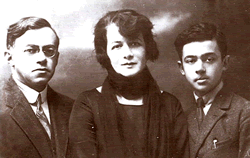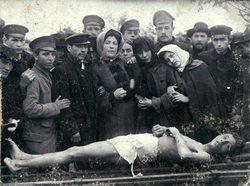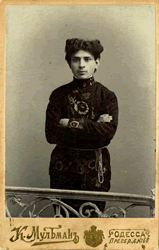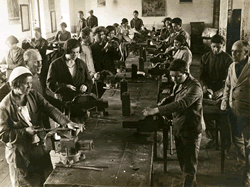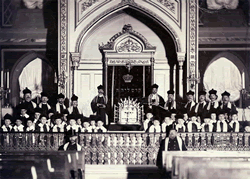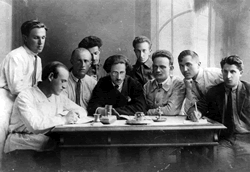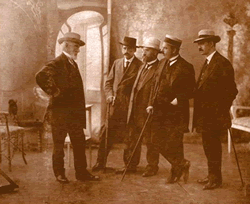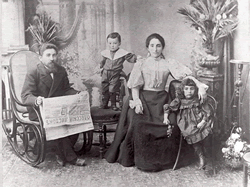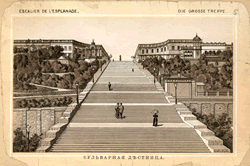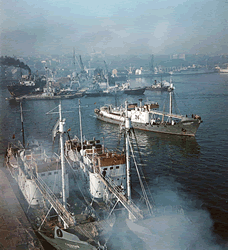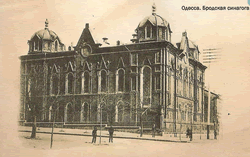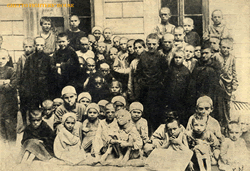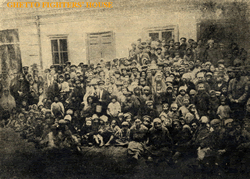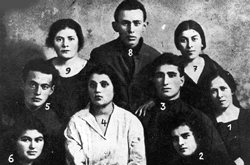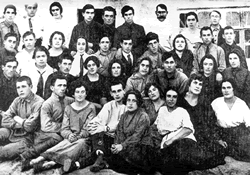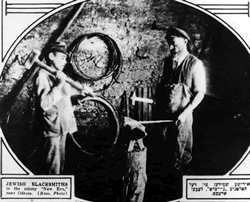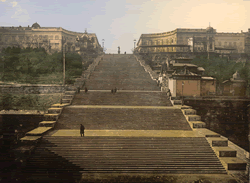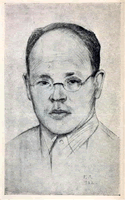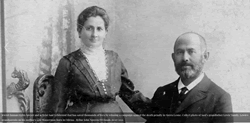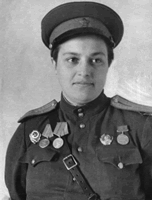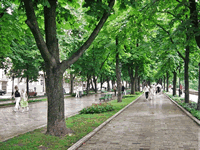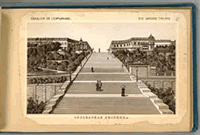#odessa-001: Lisa Buber, mother of Martin Buber (Jewish philosopher b. 1878 - d. 1965). Odessa c1880 |
#odessa-002: |
#odessa-003: Zeev Jabotinsky with his wife and son Eri (Ari). Author and Zionist leader Ze'ev Jabotinsky (b. 1880, Odessa - d. 1940, New York) |
|
#odessa-004: Mourners with the body of a Jew killed in a pogrom, Odessa, 1905. (YIVO) |
#odessa-005: Yankl, a member of the Bund, Odessa, ca. 1900. Photograph by K. Mulman. (YIVO) |
#odessa-006: By the early 1900s Odessa had become a large, thriving city, complete with European architecture and electrified urban transport. |
|
#odessa-007: Toolmaking course at the Agro-Joint Evrabmol trade school, Odessa, USSR, 1934. Evrabmol is a Russian acronym for Jewish Working Youth. (YIVO) |
#odessa-008: Jewish self-defense unit during the Russian Civil War, Odessa, 1918. This unit was better organized and had a larger arsenal than most such groups, most of whom did not have uniforms or machine guns. (YIVO) |
#odessa-009: Cantor Pin?as Minkowski (back row, sixth from right) and the boys’ choir in the Brody synagogue, Odessa, ca. 1910. (YIVO) |
#odessa-010: Activists of He-?aluts, the Zionist pioneering movement, Odessa, 1923. (The Ghetto Fighters’ Museum/Israel) |
#odessa-011: Yiddish writers (left to right) Mendele Moykher-Sforim (Sholem Yankev Abramovitsh), Alter Druyanow, Yehoshu‘a ?ana Ravnitski, ?ayim Na?man Bialik, and Yits?ak Dov Berkowitz, Odessa, ca. 1910. (Beit Bialik, Tel Aviv) |
#odessa-012: Moshe Shertok (second from left), later Moshe Sharett, the second prime minister of the State of Israel, with his parents and sister, Odessa, 1890s. (Beth Hatefutsoth, Photo Archive, Tel Aviv) |
|
#odessa-013: Négociants et marchands Israélites (Jewish Traders and Merchants). Denis Auguste Marie Raffet. Print depicting Jewish merchants in Odessa, from Voyage dans la Russie by Anatole Demidoff (Paris: Ernest Bourdin, 1840). (Gross Family Collection) |
#odessa-014: Boulevard Liestnitsa (now Potemkin Stairway), Odessa, nineteenth century. (Slavic and Baltic Division, The New York Public Library, Astor, Lenox and Tilden Foundations) |
#odessa-015: Ships at anchor in Odessa – the USSR's largest port, 1960 |
#odessa-016: |
#odessa-017: Jewish orphans in Odessa 1919 |
#odessa-018: Jews in Odessa c1920. They came as refugees from a pogrom carried out in Tetiyev |
#odessa-019: Members of a commune of He Chaluts movement in Odessa in 1924 |
#odessa-020: Members of "HaGanan" agricultural pioneering training group of He - Chaluts movement in the Odessa region. |
#odessa-021: Jewish Blacksmiths |
#odessa-022: The 142-metre-long Potemkin Stairs (constructed 1837–1841), made famous by Sergei Eisenstein in his movie The Battleship Potemkin (1925). |
#odessa-023: Bolshevik troops entering Odessa |
#odessa-024: From La-Sevivon (To the Dreydl), by Zalman Shneour (Frankfurt, Moscow, Odessa: Omanut, 1922). Illustration by ?avurat Tsayarim be-Odes (Group of Artists in Odessa). This Hebrew children's book was prepared in Odessa in 1918-1921, but issued in Frankfurt a year later, after the repression of Hebrew culture in the Soviet Union made its publication there impossible. It is believed to have been illustrated by one or more members of a group of four students from the Odessa Art Academy, who may have needed to remain anonymous for fear of persecution. (Gross Family Collection) |
#odessa-025: From Rasskazy (Stories), by Isaac Babel (Moscow: Federatsiia, 1932). Portrait of Isaac Babel by David Shterenberg. (Slavic and Baltic Division, The New York Public Library, Astor, Lenox and Tilden Foundations) |
#odessa-026: Itzhak Spivakov born in Odessa in 1874 was a Hebrew poet. He immigrated to Argentina in 1923 and passed away there n the 1950s. |
#odessa-027: Passport used by Pinhas Rutenberg in 1919 to escape from Odessa. |
| #odessa-028: Yaakov Elchanan Litvinski |
#odessa-029: The Wassermans of Odessa |
#odessa-030: |
#odessa-031: |
#odessa-032: |
#odessa-033: |
#odessa-034: |
#odessa-035: |
#odessa-036: |
#odessa-037: |
#odessa-038: |
#odessa-039: |
|
|
|
Created by Eilat Gordin Levitan
Read the original yizkor book
http://yizkor.nypl.org/index.php?id=1249
Please share your comments or photos or links for posting on our Guestbook Page here: egl.comments@gmail.com
Odessa (also known as Odesa; Ukrainian: ???´?? [??d?s?]; Russian: ???´??? [??djes?]) is the third most populous city of Ukraineand a major tourism center, seaport and transport hub located on the northwestern
shore of the Black Sea. It is also the administrative center of the Odessa Oblast and a multiethnic cultural center. Odessa is sometimes called the pearl of the Black Sea the South Capital (under the Russian Empire and Soviet Union), and Southern Palmyra. Before the Tsarist establishment of Odessa, an ancient Greek settlement existed at its location as elsewhere along the northwestern Black Sea coast. A more recent Tatar settlement was also founded at the location by Hac? I Giray, the Khan of Crimea in 1440 that was named after him as Hac?bey After a period of Lithuanian Grand Duchy control, Hacibey and surroundings became part of the domain of the Ottomans in 1529 and remained there until the empire's defeat in the Russo-Turkish War of 1792.
In 1794, the city of Odessa was founded by a decree of the Russian empress Catherine the Great. From 1819 to 1858, Odessa was a free port. During the Soviet period it was the most important port of trade in the Soviet Union and a Soviet naval base. On 1 January 2000, the Quarantine Pier at Odessa Commercial Sea Port was declared a free port and free economic zone for a period of 25 years.
During the 19th century, Odessa was the fourth largest city of Imperial Russia, after Moscow, Saint Petersburg and Warsaw. Its historical architecture has a style more Mediterranean than Russian, having been heavily influenced by French and Italian styles. Some buildings are built in a mixture of different
styles, including Art Nouveau, Renaissance and Classicist
Odessa is a warm-water port. The city of Odessa hosts both the Port of Odessa and Port Yuzhne, a significant oil terminalsituated in the city's suburbs. Another notable port, Chornomorsk, is located in the same oblast, to the south-west of Odessa. Together they represent a major transport hub integrating with railways. Odessa's oil and chemical processing facilities are connected to Russian and European networks by strategic pipelines. https://en.wikipedia.org/wiki/Odessa
Odessa was the site of a large Greek settlement no later than the middle of the 6th century BC (a necropolis from the 5th–3rd centuries BC has long been known in this area). Some scholars believe it to have been a trade settlement established by the Greek city of Histria. Whether the Bay of Odessa is the ancient "Port of the Histrians" cannot yet be considered a settled question based on the available evidence.[9]Archaeological artifacts confirm extensive links between the Odessa area and the eastern Mediterranean.
In the Middle Ages successive rulers of the Odessa region included various nomadic tribes (Petchenegs, Cumans), the Golden Horde,
the Crimean Khanate, the Grand Duchy of Lithuania, and the Ottoman Empire. Yedisan Crimean Tatars traded there in the 14th century.
Since middle of the 13th century the city's territory belonged to the
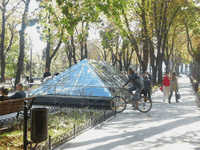
Remains of ancient Greek settlement (under glass roof) on
Golden Horde domain.[10] On Italian navigational maps of 14th century on the place of Odessa is indicated the castle of Ginestra
(more Gazaria (Genoese colonies)).[10] At times when the Northern
Black Sea littoral was controlled by the Grand Duchy of Lithuania, there existed a settlement of Kachibei which at first was mentioned in 1415.[10] By middle of 15th century the settlement was depopulated.[10]
During the reign of Khan Hac? I Giray of Crimea (1441–1466), the Khanate was endangered by the Golden Horde and the Ottoman Turks and, in search of allies, the khan agreed to cede the area to Lithuania. The site of present-day Odessa was then a fortress known as Khadjibey (named for Hac? I Giray, and also spelled Kocibey in English, Hac?bey or Hocabey in Turkish, and Hac?bey in Crimean
Tatar).support for Zionism. Beginnings of revolution
In 1905, Odessa was the site of a workers' uprising supported by
the crew of the Russian battleship
Potemkin and Lenin's Iskra. Sergei Eisenstein's famous motion
picture The Battleship Potemkin commemorated the uprising and
included a scene where hundreds of Odessan citizens were
murdered on the great stone staircase (now popularly known as the
"Potemkin Steps"), in one of the most famous scenes in motion
picture history. At the top of the steps, which lead down to the port,
stands a statue of the Duc de Richelieu. The actual massacre took
place in streets nearby, not on the steps themselves, but the film
caused many to visit Odessa to see the site of the "slaughter". The
"Odessa Steps" continue to be a tourist attraction in Odessa. The
film was made at Odessa's Cinema Factory, one of the oldest cinema studios in the former Soviet Union. Following the Bolshevik Revolution in 1917 during Ukrainian-Soviet War, Odessa saw two Bolshevik armed insurgencies, the second of which succeeded in establishing their control over the city; for the following months the city became a center of the Odessa Soviet Republic. After signing of the Brest-Litovsk Treaty all Bolshevik forces were driven out by 13 March 1918 by the combined armed forces of the Austro-Hungarian Army, providing support to the Ukrainian People's Republic
With the end of the World War I and withdrawal of armies of Central Powers, the Soviet forces fought for control over the country with the army of the Ukrainian People's Republic. A few months later the city was
occupied by the French Army and the Greek Army that supported the Russian White Army in its struggle with the Bolsheviks. The Ukrainian general Nikifor Grigoriev who sided with Bolsheviks managed to drive the unwelcome Triple Entente forces out of the city, but Odessa was soon retaken by the Russian White Army. Finally, by 1920 the Soviet Red Army managed to overpower both Ukrainian and Russian White Army and secure the city.
The people of Odessa suffered badly from a famine that resulted from the Russian Civil War in 1921–1922 due to the Soviet policies of prodrazverstka.
Revolutionary soldiers, Odessa - 1916
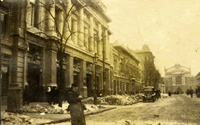
Bolshevik troops entering Odessa
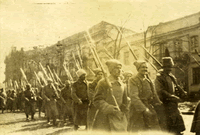
Primorsky Boulevard in Odessa[8]

World War II ]
Odessa was attacked by Romanian and German troops in August 1941. The defense of Odessa lasted 73 days from 5 August to 16 October 1941. The defense was organized on three lines with emplacements consisting of trenches, anti-tank ditches and pillboxes. The first line was 80 kilometres (50 miles) long and
about:blank Page 3 of 19
Yahoo Mail - pur in odessa main page after familiws 6/22/19, 11(09 AM
situated some 25 to 30 kilometres (16 to 19 miles) from the city. The second and main line of defense was situated 6 to 8 kilometres (3.7 to 5.0 miles) from the city and was about 30 kilometres (19 miles) long. The
third and last line of defense was organized inside the city itself.
A medal, "For the Defence of Odessa", was established on 22 December 1942. Approximately 38,000 people were awarded to servicemen of the Soviet Army, Navy, Ministry of Internal Affairs, and civil citizens who took part in the city's defense. It was one of the first four Soviet cities to be awarded the title of "Hero City" in 1945. (These others were Leningrad, Stalingrad, and Sevastopol).
Lyudmila Pavlichenko, the famous female sniper, took part in the battle for Odessa. Her first two kills were effected near Belyayevka using a Mosin-Nagant bolt-action rifle with a P.E. 4-power scope. She recorded 187 confirmed kills during the defense of Odessa. Pavlichenko's confirmed kills during World War II totaled 309 (including 36 enemy snipers).
Before being occupied by Romanian troops in 1941, a part of the city's population, industry, infrastructure and all cultural valuables possible were evacuated to inner regions of the USSR and the retreating Red Army units destroyed as much as they could of Odessa's remaining harbour facilities. The city was land mined in the same way as Kiev.[citation needed]
During World War II, from 1941–1944, Odessa was subject to Romanian administration, as the city had been made part of Transnistria Partisan fighting continued, however, in the city's catacombs.
Following the Siege of Odessa, and the Axis occupation,
approximately 25,000 Odessans were murdered in the outskirts of
the city and over 35,000 deported; this came to be known as
the Odessa massacre. Most of the atrocities were committed during
the first six months of the occupation which officially began on 17
October 1941, when 80% of the 210,000 Jews in the region were
killed,[22] compared to Jews in Romania proper where the majority
survived.[23] After the Nazi forces began to lose ground on the
Eastern Front, the Romanian administration changed its policy,
refusing to deport the remaining Jewish population to extermination
camps in German occupied Poland, and allowing Jews to work as
hired labourers. As a result, despite the tragic events of 1941, the
survival of the Jewish population in this area was higher than in other areas of occupied eastern Europe.
The city suffered severe damage and sustained many casualties over the course of the war. Many parts of Odessa were damaged during both its siege and recapture on 10 April 1944, when the city was finally liberated by the Red Army. Some of the Odessans had a more favourable view of the Romanian occupation, in contrast with the Soviet official view that the period was exclusively a time of hardship, deprivation, oppression and suffering – claims embodied in public monuments and disseminated through the media to this day.[24] Subsequent Soviet policies imprisoned and executed numerous Odessans (and deported most of the German and Tatar population) on account of collaboration with the occupiers.[25]

Soviet gun crew in action at Odessa in 1941
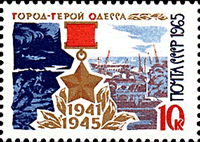
Postage stamp of the USSR 1965 “Hero-City Odessa 1941-1945”
Sniper Lyudmila Pavlichenko
Postwar history

Obverse of the Soviet campaign medal “For our Soviet homeland”

Reverse of the Soviet campaign medal “For our Soviet homeland”
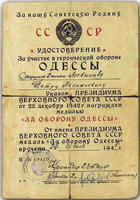
Certificate "For taking part in the heroic defense of Odessa" Logvinov Petr Leontievich was awarded the Medal for the Defense of Odessa.
Sniper Lyudmila Pavlichenko
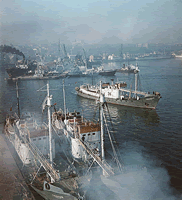
Ships at anchor in Odessa – the USSR's largest port, 1960
During the 1960s and 1970s, the city grew. Nevertheless, the majority of Odessa's Jews emigrated to Israel, the United States and other Western countries between the 1970s and 1990s. Many ended up in
the Brooklyn neighborhood of Brighton Beach, sometimes known as "Little Odessa". Domestic migration of the Odessan middle and upper classes to Moscow and Leningrad, cities that offered even greater opportunities for career advancement, also occurred on a large scale. Despite this, the city grew rapidly by filling the void of those left with new migrants from rural Ukraine and industrial professionals invited from all over the Soviet Union.
As a part of the Ukrainian Soviet Socialist Republic, the city preserved and somewhat reinforced its unique cosmopolitan mix of Russian/Ukrainian/Jewish culture and a
predominantly Russophone environment with the uniquely accented dialect of Russian spoken in the city. The city's unique identity has been formed largely thanks to its varied demography; all the city's communities have influenced aspects of Odessan life in some way

Nowadays the city is undergoing a
Odessa is a city of more than 1 million people. The city's industries
include shipbuilding, oil refining, chemicals, metalworking, and food
processing. Odessa is also a Ukrainian naval base and home to a fishing fleet. It is known for its large outdoor market – the Seventh-Kilometer Market, the largest of its kind in Europe.
The city has seen violence in the 2014 pro-Russian conflict in Ukraine during 2014 Odessa clashes. The 2 May 2014 Odessa clashesbetween pro-Ukrainian and pro-Russian protestors killed 42 people. Four were killed during the protests, and at least 32 trade unionists were killed after a trade union building was set on fire and its exits blocked by Ukrainian nationalists.[26] Polls conducted from September to December 2014 found no support for joining Russia.[27]
Odessa was struck by three bomb blasts in December 2014, one of which killed one person (the injuries sustained by the victim indicated that he had dealt with explosives).[28][29]Internal Affairs Ministry
advisor Zorian Shkiryak said on 25 December that Odessa and Kharkiv had become "cities which are being used to escalate tensions" in Ukraine. Shkiryak said that he suspected that these cities were singled out because of their "geographic position".[28] On 5 January 2015 the
city's Euromaidan Coordination Center and a cargo train car were (non-lethally) bombed.[30] Geography
Location
Odessa is situated (46°28′N 30°44′E) on terraced hills overlooking a small harbor on the Black Sea in the Gulf of Odessa, approximately 31 km (19 mi) north of the estuary of
the Dniester river and some 443 km (275 mi) south of the Ukrainian capital Kiev. The average elevation at which the city is located is around 50 metres (160 feet), while the maximum is 65 metres (213 feet) and minimum (on the coast) amounts to 4.2 metres (13.8
feet) above sea level. The city currently covers a territory of
163 km2 (63 sq mi), the population density for which is around
6,139 persons/km2. Sources of running water in the city include the
Dniester River, from which water is taken and then purified at a
processing plant just outside the city. Being located in the south of
Ukraine, the topography of the area surrounding the city is typically
flat and there are no large mountains or hills for many kilometres
around. Flora is of the deciduous variety and Odessa is known for
its tree-lined avenues which, in the late 19th and early 20th centuries, made the city a favourite year-round retreat for the Russian aristocracy.[citation needed]
The city's location on the coast of the Black Sea has also helped to create a booming tourist industry in Odessa.[citation needed] The city's Arkadia beach has long been a favourite place for relaxation, both for the city's inhabitants and its visitors.[citation needed] This is a large sandy beach which is located to the south of the city centre. Odessa's many sandy beaches are considered to be quite unique in Ukraine,[citation needed] as the country's southern coast (particularly in the Crimea) tends to be a location in which the formation of stoney and pebble beaches has proliferated.
The coastal cliffs adjacent to the city are home to frequent landslides, resulting in a typical change of landscape along the Black Sea. Due to the fluctuating slopes of land, city planners are responsible for monitoring the stability of such areas, and for preserving potentially threatened building and other structures of the city above sea level near water.[31] Also a potential danger to the infrastructure and architecture of the city is the presence of multiple openings underground. These cavities can cause buildings to collapse,
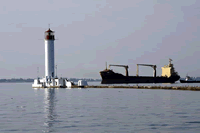 https://static-egc.xvideos-cdn.com/v3/img/player/icon-screen-fullscreen.svg
https://static-egc.xvideos-cdn.com/v3/img/player/icon-screen-fullscreen.svg
The Vorontsov Lighthouse in the Gulf of Odessa. The city is located on the Black Sea.
phase of widespread urban restoration.
resulting in a loss of money and business. Due to the effects of climate and weather on sedimentary rocks beneath the city, the result is instability under some buildings' foundations.
![]()
A panoramic view of central Odessa, as seen from the Black Sea.
Climate ]
Odessa has a hot-summer humid continental climate (Dfa, using the 0 °C [32 °F] isotherm) that borderlines the semi-arid climate (BSk) as well as a humid subtropical climate(Cfa) This has, over the past few centuries, aided the city greatly in creating conditions necessary for the development of summer tourism. During the tsarist era, Odessa's climate was considered to be beneficial for the body, and thus many wealthy but sickly persons were sent to the city in order to relax and recuperate. This resulted in the development of spa culture and the establishment of a number of high-end hotels in the city. The average annual temperature of sea is 13–14 °C (55–57 °F), whilst seasonal temperatures range from an average of 6 °C
(43 °F) in the period from January to March, to 23 °C (73 °F) in August. Typically, for a total of 4 months – from June to September – the average sea temperature in the Gulf of Odessa and city's bay area exceeds 20 °C (68 °F).[32]
The city typically experiences dry, cold winters, which are relatively mild when compared to most of Ukraine as they're marked by temperatures which rarely fall below −10 °C (14 °F). Summers on the other hand do see an increased level of precipitation, and the city often experiences warm weather with temperatures often reaching into the high 20s and low 30s. Snow cover is often light or moderate, and municipal services rarely experience the same problems that can often be found in other, more northern, Ukrainian cities. This is
largely because the higher winter temperatures and coastal location of Odessa prevent significant snowfall. Additionally the city hardly ever faces the phenomenon of sea-freezing.
Demographics
According to the 2001 census, Ukrainians make up a majority (62 percent) of Odessa's inhabitants, along with an ethnic Russian minority (29 percent)
A 2015 study by the International Republican Institute found that 68% of Odessa was ethnic Ukrainian, and 25% ethnic Russian
Despite Odessa's Ukrainian majority, Russian is the dominant language in the city. In 2015, the main
? ? ? ? ?
Climate data for Odessa (1981–2010) show
? ?
about:blank Page 7 of 19
Yahoo Mail - pur in odessa main page after familiws 6/22/19, 11(09 AM
language spoken at home was Russian − around 78% of the total population − followed by Ukrainian at 6%, and an equal combination of Ukrainian and Russian, 15%.
Odessa oblast is also home to a number of other nationalities and minority ethnic groups,
including Albanians, Armenians, Azeris, Crimean
Tatars, Bulgarians, Georgians, Greeks, Jews, Poles, Romanians, Turks, among others.[35] Up until the early 1940s the city also had a large Jewish population. As the result of mass deportation to extermination
camps during the Second World War, the city's Jewish population declined considerably. Since the 1970s, the majority of the remaining Jewish population emigrated to Israel and other countries, shrinking the Jewish community.
Through most of the 19th century and until the mid 20th century, the largest ethnic group in Odessa was Russians, with the second largest ethnic group being the Jews.
Historical ethnic and national composition
1897
1. Russians: 198,233 people (49.09%) 2. Jews: 124,511 people (30.83%)
3. Ukrainians: 37,925 people (9.39%) 4. Poles: 17,395 people (4.31%)
5. Germans: 10,248 people (2.54%)
6. Greeks: 5,086 people (1.26%)
7. Tatars: 1,437 people (0.36%)
8. Armenians: 1,401 people (0.35%) 9. Belarusians: 1,267 people (0.31%)
10. French: 1,137 people (0.28%) 1926
1. Russians: 162,789 people (39.97%) 2. Jews: 153,243 people (36.69%)
3. Ukrainians: 73,453 people (17.59%) 4. Poles: 10,021 people (2.40%)
5. Germans: 5,522 people (1.32%)
6. Belarusians: 2,501 people (0.60%) 7. Armenians: 1,843 people (0.44%) 8. Greeks: 1,377 people (0.33%)
9. Bulgarians: 1,186 people (0.28%)
10. Moldovans: 1,048 people (0.25%) 1939
1. Jews: 200,961 people (33.26%)
2. Russians: 186,610 people (30.88%) 3. Ukrainians: 178,878 people (29.60%) 4. Poles: 8,829 people (1.46%)
5. Germans: 8,424 people (1.39%)
6. Bulgarians: 4,967 people (0.82%)
7. Moldovans: 2,573 people (0.43%)
8. Armenians: 2,298 people (0.38%)
2001
1. Ukrainians: 622,900 people (61.6%) 2. Russians: 292,000 people (29.0%)
? ? ? ?
about:blank Page 8 of 19
Yahoo Mail - pur in odessa main page after familiws 6/22/19, 11(09 AM
3. Bulgarians: 13,300 people (1.3%) 4. Jews: 12,400 people (1.2%)
5. Moldovans: 7,600 people (0.7%) 6. Belarusians: 6,400 people (0.6%) 7. Armenians: 4,400 people (0.4%) 8. Poles: 2,100 people (0.2%)
Government and administrative divisions ]
Whilst Odessa is the administrative centre of the Odessa Oblast, the city is also the main constituent of the Odessa Municipality. However, since Odessa is a city of regional significance, this makes
the city subject directly to the administration of the oblast's authorities, thus removing it from the responsibility of the
municipality.
The city of Odessa is governed by a mayor and city council which work cooperatively to ensure the smooth-running of the city and procure its municipal bylaws. The city's budget is also controlled by the administration.
The mayoralty[] plays the role of the executive in the city's municipal administration. Above all comes the mayor, who is elected, by the city's electorate, for five years in a direct election. 2015 Mayoral election of Odessa Gennadiy Trukhanov was reelected in the first
round of the election with 52,9% of the vote.[1]
There are five deputy mayors, each of which is responsible for a certain particular part of the city's public
policy.
The City Council[43] of the city makes up the
administration's legislative branch, thus effectively making it a city 'parliament' or rada. The municipal council is made up of 120 elected members,[44] who are each elected to represent a certain district of the city for a four-year term. The current council is the fifth in the city's modern history, and was elected in January 2011. In the regular meetings of the municipal council, problems facing the city are discussed, and annually the city's budget is drawn up. The council has seventeen standing commissions[45] which play an important role in controlling the finances and trading practices of the city and its merchants.
The territory of Odessa is divided into four administrative raions (districts):
Kyivsky Raion (Russian: ????????? ??????, Ukrainian: ???¨??????? ??????)
Malynovsky Raion (Russian: ????????????
??????, Ukrainian: ????????????? ??????)
Prymorsky Raion (Russian: ??????????? ??????, Ukrainian: ???????????? ??????) Suvorovsky Raion (Russian, ???????????? ??????, Ukrainian: ????????????? ??????)
In addition, every raion has its own administration, subordinate to the Odessa City council, and with limited responsibilities.
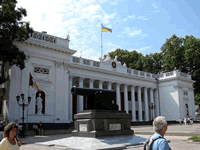
Odessa City Hall, the seat of the city's municipal authorities
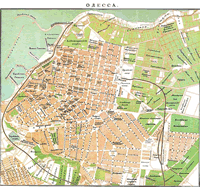
An old map of Odessa's city centre. North is to the left.
![]()
A panoramic view of Primorsky Boulevard, at the top of the Potemkin Stairs.
Further information: Odessa Catacombs
Many of Odessa's buildings have, rather uniquely for a Ukrainian city, been influenced by the Mediterranean style of classical architecture. This is particularly noticeable in buildings built by architects such as the Italian Francesco Boffo, who in early 19th-century built a palace and colonnade for the Governor of Odessa, Prince Mikhail Vorontsov, the Potocki Palace and many other public buildings.
In 1887 one of the city's most well known architectural monuments was completed – the theatre, which still hosts a range of performances to this day; it is widely regarded as one of the world's finest opera houses. The first opera house was opened in 1810 and destroyed by fire in 1873. The modern building was constructed
by Fellner and Helmer in neo-baroque; its luxurious hall was built in the rococo style. It is said that thanks to its unique acoustics even a whisper from the stage can be heard in any part of the hall. The theatre was projected along the lines of Dresden's Semperoper built in 1878, with its nontraditional foyer following the curvatures of the auditorium; the building's most recent renovation was completed in 2007.[46]
Odessa's most iconic
symbol, the Potemkin
Steps (Primorsky Stairs) is
a vast staircase that conjures an illusion so that those at the top only see a series of large steps, while at the bottom all the steps appear to merge into one pyramid-shaped mass. The original 200 steps (now reduced to 192) were designed by Italian architect Francesco Boffo and built between 1837 and 1841. The steps were made famous by Sergei Eisenstein in his film, The Battleship Potemkin.
Most of the city's 19th-century houses were built of limestone mined nearby. Abandoned mines were later used and broadened by
local smugglers. This created a gigantic complicated labyrinth of underground tunnels beneath Odessa, known as "Odessa
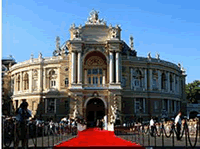
The Italian baroque facade of
the Odessa Opera and Ballet Theater.
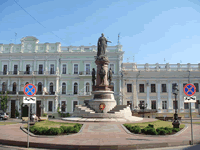
The centre of Odessa, with its statue of Catherine the Great, is one of the city's central landmark.
Catacombs". During World War II, the catacombs served as a hiding
place for partisans.
Deribasivska Street, an attractive pedestrian avenue named after José de Ribas, the Spanish-born founder of Odessa and decorated Russian Navy Admiral from the Russo-Turkish War, is famous by its unique character and architecture.[citation needed] During the summer it is common to find large crowds of people leisurely sitting and talking on the outdoor terraces of numerous cafés, bars
and restaurants, or simply enjoying a walk along the cobblestone street, which is not open to vehicular traffic and is kept shaded by
the linden trees which line its route.[47] A similar streetscape can also be found in that of Primorsky Bulvar, a grand thoroughfare which runs along the edge of the plateau upon which the city is situated, and where many of the city's most imposing buildings are to be found.
As one of the biggest on the Black Sea, Odessa's port is busy all
year round. The Odessa Sea Port is located on an artificial stretch
of Black Sea coast, along with the north-western part of the Gulf of
Odessa. The total shoreline length of Odessa's sea port is around 7.23 kilometres (4.49 mi). The port, which includes an oil refinery, container handling facility, passenger area and numerous areas for handling dry cargo, is lucky in that its work does not depend on seasonal weather; the harbour itself is defended from the elements by breakwaters. The port is able to handle up to 14 million tons of cargo and about 24 million tons of oil products annually, whilst its passenger terminals can cater for around 4 a million passengers a year at full capacity.[48]
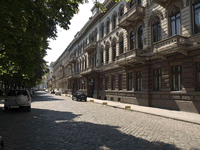
The Londonskaya Hotel, on
Odessa's magnificent Primorsky Bulvar, is one of the city's landmark buildings.
Parks and gardens
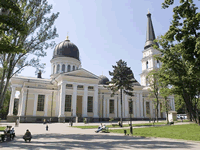
The city's Preobrazhensky Park surrounds its cathedral.
There are a number of public parks and gardens in Odessa, among these are the Preobrazhensky, Gorky and Victory parks, the latter of which is an arboretum. The city is also home to a university botanical garden, which recently celebrated its 200th anniversary, and a number of other smaller gardens.
The City Garden, or Gorodskoy Sad, is perhaps the most famous of Odessa's gardens. Laid out in 1803 by Felix De Ribas (brother of the founder of Odessa, José de Ribas) on a plot of urban land he owned, the garden is located right in the heart of

The Alexander Column in Schevchenko Park
the city. When Felix decided that he was no longer able to provide
enough money for the garden's upkeep, he decided to present it to
the people of Odessa. The transfer of ownership took place on 10
November 1806. Nowadays the garden is home to a bandstand and
is the traditional location for outdoor theater in the summertime.
Numerous sculptures can also be found within the grounds as well as a musical fountain, the waters of which are computer controlled to coordinate with the musical melody being played.
Odessa's largest park, Shevchenko Park (previously Alexander Park), was founded in 1875, during a visit to the city by Emperor Alexander II. The park covers an area of around 700 by 900 metres (2,300 by 3,000 feet) and is located near the centre of the city, on the side closest to the sea. Within the park there are a variety of cultural and entertainment facilities, and wide pedestrian avenues. In the center of the park is the local top-flight football team's Chornomorets Stadium, the Alexander Column and municipal observatory. The Baryatinsky Bulvar is popular for its route, which starts at the park's gate before winding its way along the edge of the coastal plateau. There are a number of monuments and memorials in the park, one of which is dedicated to the park's namesake, the Ukrainian national poet Taras Shevchenko.
Park zone at Primorskiy prospekt in Odessa
Education
Odessa is home to several
universities and other
institutions of higher education. The city's best-known and most prestigious university is the Odessa 'I.I. Mechnikov' National University. This university is the oldest in the city and was first founded by an edict of Tsar Alexander II of Russia in 1865 as the Imperial Novorossian University. Since then the university has developed to become one of modern Ukraine's leading research and teaching universities, with staff of around 1,800 and total of thirteen academic faculties. Other than the National University, the city is also home to the 1921-inaugurated Odessa National Economic University, the Odessa National Medical
University (founded 1900), the 1918-founded Odessa National Polytechnic University and the Odessa National Maritime University (established 1930).
In addition to these universities, the city is home to the Odessa Law Academy, the
National Academy of Telecommunications and the Odessa National Maritime Academy. The last of these institutions is a highly specialised and prestigious establishment for the preparation and training of merchant mariners which sees around 1,000 newly qualified officer cadets graduate each year and take up employment in the merchant marines of numerous countries around the world. The South Ukrainian National Pedagogical University is also based in the city, this is one of the largest institutions for the preparation of educational specialists in Ukraine and is recognised as one of the country's finest of such universities.
In addition to all the state-run universities mentioned above, Odessa is also home to a large number of private educational institutes and
academies which offer highly specified courses in a range of
different subjects. These establishments, however, typically charge
much higher fees than government-owned establishments and may not have held the same level of official accreditation as their state-run peers.[citation needed]
With regard to primary and secondary education, Odessa has a large number of schools catering for all ages from kindergarten through to lyceum (final secondary school level) age. Most of these schools are state-owned and operated, and all schools have to be state-accredited in order to teach children.
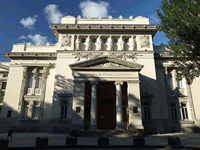
The Odessa National Scientific Library is a major research library, and centre for study, in southern Ukraine.
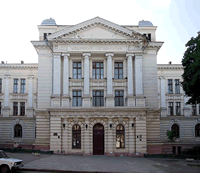
The main building of the Odessa National Medical University.
Park zone at Primorskiy prospekt in Odessa
about:blank Page 12 of 19
Yahoo Mail - pur in odessa main page after familiws 6/22/19, 11(09 AM
Culture [ ]
Main article: Culture of Odessa
Museums, art and music

Odessa Archaeological Museum was designed in the Neoclassical stylejust like many other landmarks of the city.
The Odessa Museum of Western and Eastern Art is arguably Odessa's most important museum; it has large European collections from the 16–20th centuries along with the art from the East on display. There are paintings from Caravaggio, Mignard, Hals, Teniers and Del Piombo. Also of note is the city's Alexander Pushkin Museum, which is dedicated to detailing the short
time Pushkin spent in exile in Odessa, a period during which he continued to write. The poet also has a city street named after him, as well as a statue.[49] Other museums in the city include
the Odessa Archeological Museum, which is housed in a neoclassical building, the Odessa Numismatics Museum,
the Odessa Art Museum, the Odessa Museum of the Regional History, Museum of Heroic Defense of Odessa (411th Battery).
Among the city's public sculptures, two sets of Medici lions can be noted, at the Vorontsov Palace[50] as well as the Starosinnyi Garden.[51]
Jacob Adler, the major star of the Yiddish theatre in New York and father of the actor, director and
teacher Stella Adler, was born and spent his youth in Odessa. The most popular Russian show business people from Odessa are Yakov Smirnoff (comedian), Mikhail Zhvanetsky (legendary humorist writer, who began his career as a port engineer) and Roman Kartsev (comedian ??????, ????? ????????? [ru]). Zhvanetsky's and Kartsev's success in the 1970s, along with Odessa's KVN team, contributed to Odessa's established status as "capital of Soviet humor", culminating in the annual Humoryna festival, carried out around the beginning of April.
Odessa was also the home of the late Armenian painter Sarkis Ordyan (1918–2003), the Ukrainian painter Mickola Vorokhta and the Greek philologist, author and promoter of Demotic Greek Ioannis Psycharis (1854–1929). Yuri Siritsov, bass player of the Israeli Metal band PallaneX is originally from Odessa. Igor Glazer Production Manager Baruch Agadati (1895–1976), the Israeli classical ballet dancer, choreographer, painter, and film producer and director grew up in Odessa, as did Israeli artist and
author Nachum Gutman (1898–1980). Israeli painter Avigdor Stematsky (1908–89) was born in Odessa.
Odessa produced one of the founders of the Soviet violin school, Pyotr Stolyarsky. It has also produced many musicians, including the violinists Nathan Milstein, David Oistrakh and Igor Oistrakh, Boris Goldstein, Zakhar Bron and pianists Sviatoslav Richter, Benno Moiseiwitsch, Vladimir de Pachmann, Shura Cherkassky, Emil Gilels, Maria Grinberg, Simon Barere, Leo Podolsky and Yakov Zak. (Note: Richter studied in Odessa but wasn't born there.)
The Odessa International Film Festival is also held in this city annually since 2010.
Literature
Poet Anna Akhmatova was born in Bolshoy Fontan near Odessa.] The city has produced many writers, including Isaac Babel, whose series of short stories, Odessa Tales, are set in the city. Other Odessites are
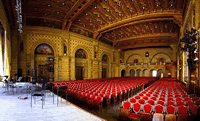
The main hall of the Odessa Philharmonic Society's theatre.
the duo Ilf and Petrov, and Yuri Olesha. Vera Inber, a poet and writer, as well as the poet and journalist, Margarita Aliger were both born in Odessa. The Italian writer, slavist and anti-
fascist dissident Leone Ginzburg was born in Odessa into a Jewish family, and then went to Italy where he grew up and lived.
One of the most prominent pre-war Soviet writers, Valentin Kataev, was born here and began his writing career as early as high school (gymnasia). Before moving to Moscow in 1922, he made quite a few acquaintances here, including Yury Olesha and Ilya Ilf (Ilf's co- author Petrov was in fact Kataev's brother, Petrov being his pen- name). Kataev became a benefactor for these young authors, who would become some of the most talented and popular Russian writers of this period. In 1955 Kataev became the first chief editor of the Youth(Russian: ??????, Yunost'), one of the leading literature magazines of the Ottepel of the 1950s and 1960s.[citation needed]
These authors and comedians played a great role in establishing the "Odessa myth" in the Soviet Union. Odessites were and are viewed in the ethnic stereotype as sharp-witted, street-wise and eternally optimistic.[citation needed] These qualities are reflected in the "Odessa dialect", which borrows chiefly from the characteristic speech of the Odessan Jews, and is enriched by a plethora of influences common for the port city. The "Odessite speech" became a staple of the "Soviet Jew" depicted in a multitude of jokes and comedy acts, in which a Jewish adherent served as a wise and subtle dissenter and opportunist, always pursuing his own well-being, but unwittingly pointing out the flaws and absurdities of the Soviet regime. The Odessan Jew in the jokes always "came out clean" and was, in the end, a lovable character – unlike some of other jocular nation stereotypes such as The Chukcha, The Ukrainian, The Estonian or The American.
Resorts and health care ]
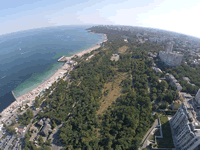
Aerial image of Langeron Beach

Sea view, Cape Langeron
leading ophthalmology clinics.
Celebrations and holidays
Further information: Humorina
Odessa is a popular tourist destination, with many therapeutic resorts in and around the city. The
city's Filatov Institute of Eye Diseases & Tissue
Therapy is one of the world's
April Fools' Day, held annually on 1 April, is one of the most celebrated festivals in the city. Practical joking is a central theme throughout, and Odessans dress in unique, colorful attire to express their spontaneous and comedic selves. The tradition has been celebrated since the early 1970s, when the humor of Ukraine’s citizens were drawn to television and the media, further developing into a mass festival. Large amounts of money are made from the festivities, supporting Odessa’s local entertainers and shops.[54]
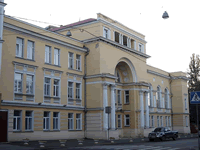
The School of Stolyarsky, founded in 1933, has long been recognised as a centre of musical excellence.
about:blank Page 14 of 19
Yahoo Mail - pur in odessa main page after familiws 6/22/19, 11(09 AM
Notable Odessans
Pyotr Schmidt (better known as "Lieutenant Schmidt"), one of the leaders of the Sevastopol uprising, was born in Odessa.
Ze'ev Jabotinsky was born in Odessa, and largely developed his version of Zionism there in the early
1920s. One Marshal of the Soviet Union, Rodion Yakovlevich Malinovsky, a military commander in World War II and Defense Minister of the Soviet Union, was born in Odessa, whilst renowned Nazi hunter Simon Wiesenthal lived in the city at one time.
Georgi Rosenblum, who was employed by William Melville as one of the first spies of the British Secret Service Bureau, was a native Odessan. Another intelligence agent from Odessa was Genrikh Lyushkov, who joined in the Odessa Cheka in 1920 and reached two-star rank in the NKVD before fleeing to Japanese-occupied Manchuria in 1938 to avoid being murdered.
The composer Jacob Weinberg (1879–1956) was born in Odessa. He composed over 135 works and was the founder of the Jewish National Conservatory in Jerusalem before immigrating to the U.S. where he became "an influential voice in the promotion of American Jewish music".[56]
Valeria Lukyanova, a girl from Odessa who looks very similar to a Barbie doll, has received attention on the Internet and from the media for her doll-like appearance.[57][58][59]
Mikhail Zhvanetsky, writer, satirist and performer best known for his shows targeting different aspects of the Soviet and post-Soviet everyday life is one of most famous living Odessans.[citation needed]
Kostyantyn Mykolayovych Bocharov, better known by his stage name, Mélovin, is a native of Odessa. He is best known for winning season six of X-Factor Ukraine and for representing Ukraine in the Eurovision Song Contest 2018, singing the song "Under the Ladder".
Economy
The economy of Odessa largely stems from its traditional role as a port city. The nearly ice-free port lies near the mouths of
the Dnieper, the Southern Bug, the Dniester and the Danube rivers, which provide good links to the hinterland.[60] During the Soviet period (until 1991) the city functioned as the USSR's largest trading port; it continues in a similar role as independent Ukraine's busiest international port. The port complex contains an oil and gas transfer and storage facility, a cargo-handling area and a large passenger port. In 2007 the Port of Odessa handled 31,368,000 tonnes of cargo.[61][62] The port of Odessa is also one of the Ukrainian Navy's most important bases on the Black Sea. Rail transport is another important sector of the economy in Odessa – largely due to the role it plays in delivering goods and imports to and from the city's port.
At present, 5% of the industrial production of Ukraine takes place in the Odessa region. [63] Industrial enterprises located in and around the city include those dedicated to fuel refinement, machine building, metallurgy, and other types of light industry such as food

Odessa's port is Ukraine's busiest.
The harbour remains accessible all year round and serves as a vital import/export channel for the Ukrainian economy.
preparation, timber plants and chemical industry. Agriculture is a relatively important sector in the territories surrounding the city. The Seventh-Kilometer Market is a major commercial complex on the outskirts of the city where private traders now operate one of the largest market complexes in Eastern Europe.[64] The market has roughly 6,000 traders and an estimated 150,000 customers per day. Daily sales, according to the Ukrainian periodical Zerkalo Nedeli, were believed to be as high as USD 20 million in 2004. With a staff of 1,200 (mostly guards and janitors), the market is also the region's largest employer. It is owned by local
about:blank Page 15 of 19
Yahoo Mail - pur in odessa main page after familiws 6/22/19, 11(09 AM
land and agriculture tycoon Viktor A. Dobriansky and three partners of his. Tavria-V is the most popular retail chain in Odessa. Key areas of business include: retail, wholesale, catering, production, construction and development, private label. Consumer recognition
is mainly attributed[by whom?] to the high level of service and the quality of services. Tavria-V is the biggest private company and the biggest tax payer.
Deribasivska Street is one of the city's most important commercial streets, hosting a large number of the city's boutiques and higher-end shops. In addition to this
there are a number of large commercial shopping centres in the city. The 19th-century shopping gallery Passage was, for a long time, the city's most upscale shopping district, and remains to this day an important landmark of Odessa.
The tourism sector is of great importance to Odessa, which is
currently[when?] the second most-visited Ukrainian city.[65] In 2003
this sector recorded a total revenue of 189,2 mln UAH. Other
sectors of the city's economy include the banking sector: the city
hosts a branch of the National Bank of Ukraine. Imexbank, one of
Ukraine's largest commercial banks, is based in the city. Foreign
business ventures have thrived in the area, as since 1 January
2000, much of the city and its surrounding area has been
declared[by whom?] a free economic zone– this has aided the foundation of foreign companies' and corporations' Ukrainian divisions and allowed them to more easily invest in the Ukrainian manufacturing and service sectors. To date a number of Japanese and Chinese companies, as well as a host of European enterprises, have invested in the development of the free economic zone, to this end private investors in the city have invested a great deal of money into the provision of quality office real estate and modern manufacturing facilities such as warehouses and plant complexes.
Scientists
A number of world-famous scientists have lived and worked in Odessa. They include: Illya Mechnikov (Nobel Prize in Medicine 1908),[66] Igor Tamm (Nobel Prize in Physics 1958), Selman Waksman (Nobel Prize in Medicine 1952), Dmitri Mendeleev, Nikolay Pirogov, Ivan Sechenov, Vladimir Filatov, Nikolay Umov, Leonid Mandelstam, Aleksandr Lyapunov, Mark Krein, Alexander Smakula, Waldemar Haffkine, Valentin Glushko, and George Gamow.[67]
Transport ] Maritime transport
Further information: UkrFerry and Black Sea Shipping Company
Odessa is a major maritime-transport hub that includes several ports including Port of Odessa, Port of
Chornomorsk(ferry, freight), Yuzhne (freight only). The Port of Odessa became a provisional headquarters for the Ukrainian Navy, following the Russian occupation of Crimea in 2014. Before the fall of the Soviet Union, the Port of Odessa harbored the major Soviet cruise line Black Sea Shipping Company.
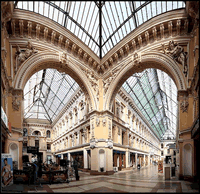
The Passage galleries, one of the city's landmarks.
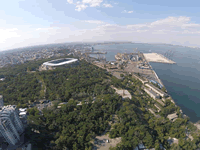
Odessa seaport
Passenger ships and ferries connect Odessa with Istanbul, Haifa and Varna, whilst river cruises can occasionally be booked for travel up the Dnieper River to cities such
as Kherson, Dnipro and Kiev.
Roads and automotive transport [ edit ]
The first car in the Russian Empire,
a Mercedes-Benz belonging to V. Navrotsky, came to Odessa from
France in 1891. He was a popular city publisher of the newspaper The Odessa Leaf.
Odessa is linked to the
Ukrainian capital, Kiev, by
the M05 Highway, a high
quality multi-lane road which is set to be re-designated, after further reconstructive works, as an 'Avtomagistral' (motorway) in the near future. Other routes of national significance, passing through Odessa, include the M16 Highway to Moldova, M15
to Izmail and Romania, and the M14 which runs from Odessa, through Mykolaiv and Kherson to Ukraine's eastern border with Russia. The M14 is of particular importance to Odessa's maritime and shipbuilding industries as it links the city with Ukraine's other large deep water port Mariupol which is located in the south east of the country.
Odessa also has a well-developed system of inter-urban municipal roads and minor beltways. However, the city is still lacking an extra-urban bypass for transit traffic which
does not wish to proceed through the city centre.
Intercity bus services are available from Odessa to many cities in Russia (Moscow, Rostov-on- Don, Krasnodar, Pyatigorsk), Germany (Berlin, Hamburg and Munich), Greece
(Thessaloniki and Athens), Bulgaria (Varna and Sofia) and several cities of Ukraine and Europe.
Railways
Odessa is served by a number of railway stations and halts, the largest of which is Odesa Holovna (Main Station), from where passenger train services connect Odessa with Warsaw,
Prague, Bratislava, Vienna, Berlin, Moscow, St. Petersburg, the cities of Ukraine and many other cities of the former USSR. The city's first railway station was opened in the 1880s, however, during the Second World War, the iconic building of the main station, which had long been considered to be one of the Russian Empire's premier stations, was destroyed through enemy action. In 1952 the station was rebuilt to the designs of A Chuprina. The current station, which is characterised by its many socialist-
realist architectural details and grand scale, was renovated by the state railway operator Ukrainian Railways in 2006.
Public transport
In 1881 Odessa became the first city in Imperial Russia to have steam tramway lines, an

Soviet cruise line based in Odessa

Odessa has long been an important Black Sea port.

The M05 Highway links Odessa with the nation's capital, Kiev. Odessa junction.
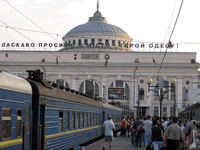
Odesa Holovna is one of Ukraine's largest railway terminals. Every day trains depart to a large number of national and international destinations.
innovation that came only one year after the establishment of horse tramway services in 1880 operated by the "Tramways d'Odessa", a Belgian owned company. The
first metre gauge steam tramway line ran from Railway Station to Great Fontaine and the second one to Hadzhi Bey Liman. These routes were both
operated by the same Belgian company. Electric tramway started to operate on 22 August 1907. Trams were imported from Germany.
The city's public transit system is currently made up of trams,[68] trolleybuses, buses and fixed-route taxis (marshrutkas). Odessa also has a cable car to Vidrada Beach,] and recreational ferry service.
One additional mode of transport in Odessa is quite unique; the Potemkin Stairs funicular railway, which runs between the city's Primorsky Bulvar and the sea terminal, has been in service since 1902. In 1998, after many years of neglect, the city decided to raise funds for a replacement track and cars. This project was delayed on multiple occasions but was finally completed eight years later in 2005.[70] The funicular has now become as much a part of historic Odessa as the staircase to which it runs parallel.
Air transport
Odessa International Airport, which is located to the south-west of the city centre, is served by a number of airlines. The airport is also often used by citizens of neighbouring countries for whom Odessa is the nearest large city and who can travel visa-free to Ukraine.
Transit flights from the Americas, Africa, Asia, Europe and the Middle East to Odessa are offered by Ukraine International Airlines through their hub at Kiev's Boryspil International Airport. Additionally Turkish Airlines wide network and daily flights offers more than 246 destinations all over the world.
An Odessa tram on Sofievska Street.
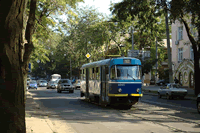
Sport [ edit ]
See also: Category:Sport in Odessa
Odessa funicular
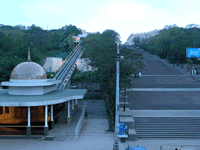
The most popular sport in
Odessa is football. The main professional football club in the city is FC Chornomorets Odesa, who play in the Ukrainian Premier League. Chornomorets play their home games at
the Chornomorets Stadium,
an elite-class stadium
which has a maximum
capacity of 34,164. The
second football team in Odessa is FC Odessa.
Basketball is also a prominent sport in Odessa, with BC
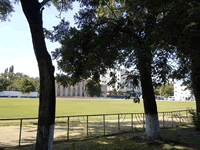
Stadium of the Krayan Sports Complex
Chornomorets Stadium renovated in preparation to the Euro 2012
Odessa representing the city in the Ukrainian Basketball League, the highest tier basketball league in Ukraine. Odessa will become one of five Ukrainian cities to host the 39th European Basketball Championship in 2015.
Athletes
Chess player Efim Geller was born in the city. Gymnast Tatiana
Gutsu (known as "The Painted Bird of Odessa") brought home
Ukraine's first Olympic gold medal as an independent nation when
she outscored the USA's Shannon Miller in the women's all-around
event at 1992 Summer Olympics in Barcelona, Spain. Figure
skaters Oksana Grishuk and Evgeny Platov won the 1994 and 1998 Olympic gold medals as well as the 1994, 1995, 1996, and 1997 World Championships in ice dance. Both were born and raised in the city, though they skated at first for the Soviet Union, in the Unified Team, the Commonwealth of Independent States, and then Russia. Hennadiy Avdyeyenko won a 1988 Olympic gold medal in thehigh jump, setting an Olympic record at 2.38 metres (7.81 feet).
Other notable athletes:
Mykola Avilov, Olympic champion in decathlon at the 1972 Summer Olympics in Munich Oksana Baiul, Olympic champion in figure skating in 1994
Ihor Belanov, European Footballer of the Year in 1986
Yuriy Bilonoh, European Athletics Championships in shot put at 2002 in Munich
Leonid Buryak (born 1953), football coach and former Olympic bronze-medal-winning player
Maksim Chmerkovskiy, professional ballroom & Latin dancer on American Dancing With the Stars Valentin Chmerkovskiy, professional ballroom & Latin dancer on American Dancing With the Stars Charles Goldenberg (1911–1986), NFL All-Pro football player
Viktor Kanevskyi (born 1936), football player and coach
Svetlana Krachevskaya, Olympic silver medalist in shot put
Viacheslav Kravtsov, NBA basketball player
Lenny Krayzelburg (born 1975), Olympic champion swimmer
Artur Kyshenko, K1 Muay Thai kickboxer
Yevgeny Lapinsky, Olympic champion in volleyball at the 1968 Summer Olympics in Mexico
Roman Pelts, Soviet chess master
Viktor Petrenko, Olympic champion in figure skating in 1992
Vladimir Portnoi, Olympic silver and bronze medalist in gymnastics
Vitaliy Pushkar, racing driver, No. 6 in 2012 International Rally Challenge Production cup standings[71] Theodore Rezvoy, ocean rower, Guinness records holder (twice)
Ekaterina Rubleva, Russian ice dancing champion
Yulia Ryabchinskaya, Olympic champion in the K-1 500 m Kayak Singles at the 1972 Summer Olympics in Munich
Dmitry Salita (born 1982), boxer
Michael Shmerkin (born 1970), Israeli competitive figure skater
Elina Svitolina (born 1994), professional tennis player
Olena Vitrychenko, world champion in rhythmic gymnastics
Andriy Voronin (born 1979), football manager and player
Yakov Zheleznyak, Olympic champion in 50 m Running Target at the 1972 Summer Olympics in Munich Dayana Yastremska (born 2000), professional tennis player
Jewish Odessa ( from YIVO)
Founded in 1794 on land conquered from the Turks on the site of the Black Sea fortress town of Khadzhibei, Odessa received its name the following year. Within a few decadesit was already a sizable city and soon commanded an international reputation as the preeminent Russian grain-exporting center. However, it would retain the aura of a new place: transitory, irreverent, neither cosmopolitan nor urbane.

At the core of Odessa Jewry’s commercial and cultural elite in the 1820s were emigrants from Galicia—mostly from Brody—who first opened branch offices and then moved to Odessa, working mainly as middlemen in the grain trade. Some emerged as leading grain exporters. About 300 Galician Jewish families settled in Odessa in the 1820s and 1830s; the Rafalovichs and Efrusis, as well as a small cluster of other families of Galician origin, eventually represented the apex of local commercial life. Galicians soon assumed communal leadership, overseeing local synagogue life and launching the city’s first modern Jewish school. Its director, Betsal’el Stern (appointed in 1829), and many of its first teachers were followers of the Galician Haskalah. Traditional Jews exerted only limited influence: “Seven miles around Odessa burn the fires of Hell,” a saying widely used among Russian Jews, may well have originated as early as the 1820s.
Beginning with the establishment in 1826 of a modern Jewish school for boys, with one for girls following in 1835, and the subsequent consolidation of modernized synagogues in the 1840s and thereafter, Odessa Jewry was recognized as an important center of Russian Jewish institutional innovation; by the 1860s, it was agreed that there was no more influential center within the empire. Odessa was among the first Jewish communities in Russia where synagogue reform was a matter of communal consensus, not debate. Though the interplay of economic, social, and cultural modernization was not altogether unusual in Russian Jewish life, the impact of such forces in Odessa was immeasurably greater than in other cities. The presence of influential Haskalah institutions (schools, synagogues, newspapers and journals, clubs, and, by 1867, the largest branch of the Society for the Promotion of Culture [or Enlightenment] among the Jews of Russia [known by its initials in Russian as the OPE] outside Saint Petersburg) provided substantial ideological buttressing.
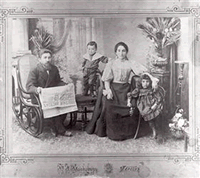
In the 1860s, Odessa became the empire’s center for Jewish periodical publication. Razsvet, Sion, and Den’ appeared in Russian-language editions between 1860 and 1871; Ha-Melits and Kol mevaser were issued in Hebrew and Yiddish in the same period. By the late 1860s, major Jewish book publishers opened for business, promoting maskilic books.
Some 2,500 students had graduated from Odessa’s modern Jewish school by 1852. By 1877, at one of the city’s commercial high schools 77.9 percent of students were Jewish; in other schools in the city the number was as high as 71.6 percent, with such rates not infrequently found highest in girls’ schools. As early as the late 1850s, a second generation of Russian-speaking Jews—among them budding writers and physicians—had emerged.
By mid-century, Odessa began to attract some of Russia’s most ambitious Jewish writers in several languages: Hebrew (Sim?ah Pinsker, Perets Smolenskin, Eliyah Werbel), French (Joachim Tarnopol), and Russian Jewish (Osip Rabinovich, Menashe Morgulis, Il’ia Orshanskii). Local Jewish-born intellectuals included Mark Wahltuch, who in 1855 published the first Italian translation of Pushkin. Another was Maria Saker, a longtime resident and one of the most innovative liberal Jewish educators in Russia; in 1869 she became the first woman to have her work published in the Russian Jewish press. Yiddish writer Yisroel Aksenfeld, author of Dos shterntikhl (The Headband; 1861), lived in the city from 1824 to 1864. The Yiddish literary luminary Sholem Yankev Abramovitsh (who wrote under the name Mendele Moykher-Sforim) lived there for most of his adult life. Yiddish theater was first consolidated in Odessa, with Avrom Goldfadn, a leading pioneer, settling there in 1858 after some years spent in Romania. The Yiddish actor Yankl Adler was born in 1870 into an Odessa grain merchant’s family. Local cabarets staged Yiddish plays. Odessa’s lively bars and public halls influenced the creation and diffusion of klezmer music.
Odessa was a singularly musical place, with its theater and, later, its opera house perhaps its most revered cultural institutions. From the city’s earliest years, Jews made their presence known as devotees of music as well as musicians. Already in the 1830s and 1840s, Jews were attending the theater in large numbers. Local violin teachers attracted many Jewish students early in the century; for example, the careers of Mischa Elman and David Oistrakh were launched there. Cantorial music thrived in this atmosphere, and Odessa’s cantors—notably Pin?as Minkowski in the years just prior to the revolution—were among the most famous in Russia.
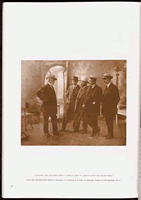
In the last quarter of the nineteenth century, Odessa lost its Jewish press to Saint Petersburg. In addition, many Jewish university students left to attend higher institutions abroad, as a result of quotas introduced under Alexander III. Notwithstanding these losses, the city’s stature as a Jewish intellectual hub was strengthened in the 1880s and 1890s. In 1897, Odessa boasted the second largest Jewish population (after Warsaw) in the empire, numbering 139,984, or 34.6 percent of the city’s total population. Its modern Jewish schools as well as its literary and philanthropic associations attracted maskilimfrom smaller towns. By late century, it was the home of Ahad Ha-Am, Mosheh Leib Lilienblum, Simon Dubnow, ?ayim Na?man Bialik, El?anan Leib Lewinsky, and Yehoshu‘a Ravnitski. However, in Odessa the Enlightenment belief that the prime task was to invigorate Judaism with European norms was viewed—not infrequently by more acculturated, Russified local Jews—as tepid, even passé. Resentment at the hands of local, secularly educated Jews was a key ingredient in the making of the cultural nationalist agendas for which these intellectuals—dubbed “the sages of Odessa”—became best known.
Jewish communal institutional life in Odessa was rich and varied. Wealth, prominence in municipal affairs, geographical distance from traditional Jewish centers, and (eventually) a long history of institutional innovation created a receptive atmosphere. Odessa’s local Talmud Torah (headed for many years by Mendele Moykher-Sforim) was widely lauded. The Jewish hospital (which served non-Jews as well) occupied four city blocks by the turn of the century. The local Jewish clerks’ association boasted one of the finest lending libraries in the Pale of Settlement (its holdings in Hebrew and Yiddish were cataloged by Ahad Ha-Am and Dubnow).
The Odessa branch of the Society for the Promotion of Culture among Jews had between 1,000 and 1,500 members by the turn of the century; its debates concerning prerequisites for modern Jewish culture helped recast the agenda of Russian Jewish life. The artisanal school, Trud, praised throughout the empire, was a model of cutting-edge, technical education. The local club Beseda, started in 1863, was widely viewed as an exemplar for middle-class Jewish conviviality and intellectual discussion.
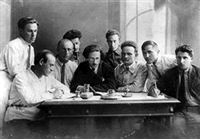
Until his death in 1891, the Odessa Committee of ?oveve Tsiyon, the nerve center of Russian Zionism, was headed by Leon (Lev) Pinsker, local physician and author of Autoemancipation.Beginning in 1905, it was in the hands of Avraham Mena?em Mendel Ussishkin. Odessa’s central role in Zionism was consolidated, in part, because it was the main port of exit to the Ottoman Empire and consequently served as the departure point for many Jewish immigrants to Palestine.
Jews held a prominent place among Odessa’s free professionals, especially its doctors. In 1881, half of those who practiced medicine in Odessa—including dentists, midwives, and pharmacists—were Jewish. The city’s Jews also had a major voice in the local Russian press. By the 1890s, two of Odessa’s three dailies were owned by Jews. All three liberal newspapers—Odesskie novosti (by far the most popular among Jewish readers and others), Odesskii listok, and Uzhnoe obozrenie—were staffed by Jewish writers, including the young Vladimir Jabotinsky. Despite the prominence of Jewish nationalists such as Ahad Ha-Am, most members of the local Jewish intelligentsia were acculturated, skeptical of Jewish nationalism, and liberal (or, in some instances, politically radical) in their inclinations. Perhaps the best-known local liberal Jewish voice in the late imperial period was the Cadet leader Osip Pergament. Still, the assimilationist profile of the Jewish community, including its best educated and youngest, should not be exaggerated. In 1911–1912, a mere 34.5 percent of the city’s Jewish students said Russian rather than Yiddish was spoken in their parents’ homes; only 16.1 percent said they had no interest in Jewish matters; and 40.6 percent claimed a good knowledge of Hebrew.
Despite Odessa’s (not wholly undeserved) reputation for comfort, there were numerous poor in this port city. About one-third of the city’s Jews at the turn of the twentieth century registered for Passover relief. Although constituting more than one-third of the city’s population in 1881, Jews owned barely one-eighth of the homes. The Jewish poor were concentrated in the Moldavanka district near the port, an area of unpaved streets that was popularized in the early 1920s in Isaac Babel’s Odessa stories. By the turn of the century, some 26,000 store clerks, including women, worked in Odessa—many of them Jews and nearly all poorly paid. Jews were prominently represented among the city’s underworld. As of 1908, 30 of the 36 licensed brothels in Kherson province—most of them in Odessa—were owned by Jews.
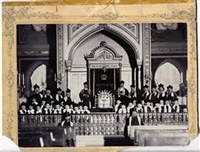
Immigrants, both Jewish and non-Jewish, poured into the city in increasingly large numbers in the late nineteenth and early twentieth centuries and found jobs in its numerous workshops and at the port. Odessa was viewed—not without justification—by the government as a center for the smuggling of radical literature; censorship in this remote part of the empire tended to be lax, with illegal literature more accessible. The presence of a large, rootless population with a disproportionate number of men without families, widespread poverty, and the circulation of an ample supply of illegal literature contributed to the growth of political radicalism. Jewish students were prominent in local populist circles in the 1870s, with the Trud school emerging by the 1890s as a magnet for radical politics. The Odessa Committee of the Social Democratic Workers Party, founded in 1894, was made up mostly of Jewish artisans and workers. Concurrent with Odessa’s economic downturn in the late nineteenth century were increases in political tensions and ethnic strife.
Interethnic disagreements frequently erupted in violence. Tension, especially between Greeks and Jews, periodically escalated into pitched battles (in 1821, 1859, and 1871), typically during Easter, a by-product of religious suspicion, nationalist sentiment among Greeks, and competition between the groups in the local grain trade. The 1871 incident, which lasted for three days, was later seen as a precursor to the far more widespread pogroms of 1881. The latter, part of a wave of attacks against Jews in some 200 localities in the southern provinces of the Pale of Settlement, was mostly thwarted in Odessa by local authorities, but the devastating wave of pogroms of 1905 led to the murder of 300 Jews in Odessa, including more than 50 members of Jewish self-defense groups. Tens of thousands of Jews were left homeless.
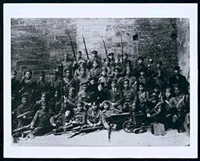
During the revolution and the civil war, Odessa did not experience widespread violence comparable to that which convulsed much of Ukraine. The city passed back and forth nine times between Russian “Whites,” Ukrainian nationalists, the French, and Communists. Soviet control was consolidated in 1920. Soon Jewish schools, synagogues, and other religious groups, including nearly all non-Bolshevik cultural institutions, were closed. The Evsektsiia and Komsomol waged vigorous campaigns against recalcitrant Hebraists (Bialik and many other leading writers who wrote in Hebrew left Odessa, with official permission, in 1921), as well as against persistent ritual customs such as circumcision.
Between 1917 and 1919—an exceptionally fertile period for Hebrew-language publications in Russia—Odessa had produced 60 percent of all Hebrew books published in Russia and Ukraine. This situation changed rapidly. As of 1923, there were a total of 12 officially sanctioned Yiddish-language schools in Odessa (none in Hebrew). A Jewish vocational school continued to function throughout the 1920s; and despite widespread unemployment, most of the city’s Jews remained concentrated in their standard prerevolution occupations. The city’s many first-rate Jewish libraries were combined into one, the Mendele Moykher-Sforim library. A museum by that name, which opened in Odessa in 1924, closed in 1933. One Yiddish-language newspaper appeared three or four times a week in Odessa as of 1935. As late as 1940, Sha’ul Borovoi, perhaps the last active Jewish historian of Russia, continued laboring in Odessa on an ever-shrinking range of acceptable Jewish scholarly topics; he lived for another four decades, consigning the remainder of Jewish scholarly work to his personal papers.
In 1925, Odessa’s Brody Synagogue was turned into the Rosa Luxemburg Workers Club. This and other workers’ clubs in the 1920s became a focal point for Jewish camaraderie and socialist propaganda. Yiddish theater continued to exist in the city in the 1930s. The city’s Jewish population as of 1939 numbered approximately 180,000.
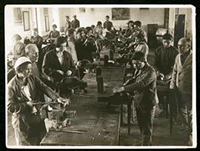
By the 1930s, the city’s Jewish educational system had disappeared, and Jews had lost prominent positions in the city’s bureaucracy. With the exception of the local Yiddish theater, nearly all visible Jewish communal life ceased. Beginning in the mid-1920s and continuing until World War II, most of what had been a variegated, institutionally rich, highly innovative local prerevolutionary Jewish culture was increasingly reduced. Nonetheless, an especially vibrant use of language set Odessa and its Jews apart. A medley of Ukrainian, Russian, and especially Yiddish resonated on the city streets and—as was widely commented upon at the time—in the literary work of Isaac Babel and the songs of Leonid Utesov (L. I. Vaisbein). Both incorporated the mythology of Odessa—its underworld types, debaucheries, and vitality—into their work. Il’ia Il’f and Evgenii Petrov, also from Odessa, drew on this vein of sardonic humor for their popular comic novels Dvenadtsat’ stul’ev(Twelve Chairs; 1928), and Zolotoi telenok (The Little Golden Calf; 1931).
Following a siege lasting two months, on 17 October 1941 the Romanians and Germans occupied Odessa, which was officially declared part of Romanian Transnistria. Jews were immediately registered separately, with some 8,000 slaughtered during the few first days. Many Jews had fled the city during the siege; there were between 80,000 and 90,000 Jews residing there at the time it was invaded. By war’s end, only 5,000 remained alive.
Less than two weeks after the Romanian occupation, approximately 19,000 Jews were burned to death in a square beside the harbor. Thousands were transported to nearby camps in Berezovka, Domanevka, and Bogdanovka. As of late 1941, only 30,000 Jews remained in two ghettos in Odessa; by February 1942 nearly all had been deported and killed. In 1943, just 54 Jews were listed as residing legally in Odessa. Soviet troops recaptured the city on 10 April 1944. Statistics on the city’s immediate postwar population are imprecise, but as many as 180,000 Jews were living in Odessa—the vast majority recent arrivals—as of the late 1950s. In 1970, the Jewish population was officially listed as 116,087, representing 13 percent of the total.
Postwar Odessa was known for its particularly blatant forms of antisemitism, which many claimed was more prevalent than in other large cities in the Soviet Union. As of the mid-1950s, the bakingof Passover matzot was expressly forbidden in Odessa and a handful of other cities. The anti-Zionist campaign of the 1960s was singularly vicious, involving trials of accused Zionists and attacks against Israeli diplomats in the local press. In 2000, out of a total population of 1.1 million, approximately 40,000 Jews lived in Odessa—some claim the number was considerably higher—with an equal number having immigrated, beginning in the 1970s, to the United States (most visibly to the Brighton Beach section of Brooklyn, New York) and to Israel. In the 1990s, with the help of the Joint Distribution Committee (JDC), as well as considerable local initiative, new Jewish organizations were established, including schools, libraries, synagogues, two newspapers, a People’s University (with some 100 students), and extensive welfare projects for the elderly and needy. The city continues to inspire contemporary Russian-language fiction about its Jewish life, instilling a lingering nostalgia among its former residents.
Suggested Reading
Ra?el Arbel, ed., Me?evah le-Odesah (Tel Aviv, 2002), in Hebrew and English; Saul Iakovlevich Borovoi, Vospominaniia (Moscow, 1993); Maurice Friedberg, How Things Were Done in Odessa: Cultural and Intellectual Pursuits in a Soviet City (Boulder, Colo., 1991); Guido Hausmann, Universität und städtische Gesellschaft in Odessa, 1865–1917 (Stuttgart, 1998); Patricia Herlihy, Odessa: A History, 1794–1914 (Cambridge, Mass., 1986); I[gor] Kotler, Ocherki po istorii evreev Odessy (Jerusalem, 1996); Dan Miron, Bodedim be-mo‘adam (Tel Aviv, 1987); Mikhail Polishchuk, Evrei Odessy i Novorossii (Jerusalem and Moscow, 2002); Michael Stanislawski, Zionism and the Fin-de-Siècle: Cosmopolitanism and Nationalism from Nordau to Jabotinsky (Berkeley, 2001); Steven J. Zipperstein, The Jews of Odessa: A Cultural History, 1794–1881 (Stanford, Calif., 1985); Steven J. Zipperstein, Elusive Prophet: Ahad Ha’am and the Origins of Zionism (Berkeley, 1993).
Author
The Jews of ODESSA from https://www.jewishvirtuallibrary.org/odessa
Short general history of the area; In the 19th century Odessa became the industrial and commercial center for southern
Russia. In 1865 a university was founded. Odessa was an important center of the Russian revolutionary movement.
Under the Soviet regime it lost some of its importance. In October 1941 Odessa was occupied by the German and Romanian
armies and was under Romanian military rule until its liberation in April 1944.
The Jewish History
From the 1880s until the 1920s the Jewish community of Odessa was the second largest in the whole of czarist Russia
(after *Warsaw, the capital of Poland, then within czarist Russia) and it had considerable influence on the Jews of the
country. The principal characteristics of this community, and responsible for its particular importance, were the rapid and
constant growth of the Jewish population and its extensive participation in the economic development of the town,
the outstanding "Western" character of its cultural life and numerous communal institutions, especially educational and
economic institutions, the social and political activity of the Jewish public, the mood of tension and struggle which was
impressed on its history, and the Hebrew literary center which emerged there.
Beginnings of the Community
The Russians found six Jews when they took the fortress of Khadzhi-Bei in 1789; the oldest Jewish tombstone in the
cemetery dates from 1793. Five Jews were among those who in 1794 received plots for the erection of houses and shops and
the planting of gardens. The Gemilut ?esed Shel Emet society (?evra kaddisha) was founded in 1795. In 1796 Jews
participated in the administration of the town. The kahal (community administration) was already in existence in 1798, when
the first synagogue was built; the first rabbi to hold office, in 1809, was Isaac Rabinovich of Bendery.
Growth of the Jewish Population
There were 246 Jews (out of a total population of 2,349) in 1795, 6,950 (out of 41,700) in 1831, 51,378 (out of 193,513) in 1873,
138,935 (out of 403,815) in 1897. During the Soviet period the Jewish population continued to grow: in 1926, 153,243
(of a total population of 420,862), and 200,981 in 1939 (out of 604,217). It was then the second largest Jewish population in
Ukraine, after Kiev. After World War II 108,900 Jews lived in Odessa (12.1% of the total) in 1959, and 86,000 (8.4% of the total)
in 1979.
Economic Status
From the start, the Jews of Odessa engaged in retail trade and crafts. Their representation in these occupations remained
important. In 1910, 56% of the small shops were still owned by Jews; they also constituted 63% of the town's craftsmen.
Jewish economy in Odessa was distinguished by the role played by Jews in the export of grain via the harbor,
in wholesale trade, banking and industry, the large numbers of Jews engaged in the liberal professions, and the existence
of a large Jewish proletariat in variegated employment.
During the first half of the 19th century, the participation of Jews in the grain export trade was limited to the purchase of grain
in the villages and estates, and to brokerage and mediation in the capacity of subagents for the large export companies,
which were Greek, Italian, and French. By 1838 Jews were well represented among the officials of the exchange, and as
classifiers, sorters, weighers, and even loaders of grain. From the 1860s, however, Jewish enterprises won a predominant
place in the grain export and succeeded in supplanting the export companies of foreign merchants from their monopolist
positions. During the early 1870s, the greater part of the grain exports was handled by Jews, and by 1910 over 80% of grain
export companies were Jewish owned, while Jews were responsible for almost 90% (89.2%) of grain exports. This success
in Jewish trade was not only due to greater efficiency in the organization of purchases and rapidity in their expedition, but
was also connected with the constant rise of grain prices and the decline of commercial profit rates, which resulted in a
tremendous increase of the grain exports which passed through the port of Odessa.
Jews also held an important share of the wholesale trade; about one-half of the wholesale enterprises were owned by Jews
in 1910. During the 1840s most of the bankers and moneychangers were Jews, and at the beginning of the 20th century 70% of
the banks of Odessa were administered by them. Among the industrialists, Jews formed 43%, but their manufactured
products amounted only to 39%. In 1910, 70% of those engaged in medicine were Jews; about 56% of those engaged in law,
and about 27% of those engaged in technical professions (engineers, architects, chemists, etc.). About two-thirds of the
Jewish population were engaged in crafts and industry, in transportation and services, and in other categories of labor.
More than one-half of these (about one-third of the Jewish population) belonged, from the social point of view,
to the proletariat – industrial workers, apprentices in workshops, and ordinary laborers. During the 1880s these formed a
considerable part of the Jewish proletariat (about one-third), and their standard of living, as that of the poorer classes, was very
low. With the progress of industrialization in Odessa, many of them were integrated in new enterprises and the number of
unskilled workers decreased.
The October Revolution of 1917 brought a decline in the commercial status of Odessa as well as the process of socialization.
While this affected the means of livelihood of the majority of Jews, much of their experience and skills were utilized in the
new social and economic structure under different designations. In 1926 Jews formed the overwhelming majority of the
commercial clerks (in government stores and cooperatives), about 90% of the members of the tailors' union, 67% of the
members of the printing workers' union, about 53%
of those employed in the timber industries, about 48% of the municipal workers (which also included drivers, electricians, etc.),
and about 40% of the members of the free professionals' union. Thousands of Jewish workers found employment in heavy
industry (metal industry, sugar refineries, ship building), in which Jews had formerly been absent, and of which only 27% were
members of the trade unions: during the same year, the Jews formed up to 64% of those engaged in the smaller private
industries which occupied some of those thousands who had remained unemployed and had not been successfully integrated
within the new economic regime.
Cultural Trends
From the cultural aspect the Odessa community was the most "Western" in character in the *Pale of Settlement. Its population
was gathered from all the regions of Russia and even from abroad (particularly from *Brody in Galicia and from Germany,
during the 1820s–30s), and the throwing off of tradition became a quite familiar occurrence. This situation was expressed by a
popular Jewish saying: "The fire of Hell burns around Odessa up to a distance of ten parasangs." The low standard of Torah
learning within the community and the general ignorance and apathy of the Odessa Jews in their attitude to Judaism were
depicted in popular witticisms as well as in literature (Y.T. *Lewinsky). Linguistic and cultural Russianassimilation encompassed
widespread classes and thus formed a social basis for the community's role as an active and organized center for the
spread of Russian education among the Jews of southern Russia. The social and economic position of the maskilim of
Odessa (the "Brodyists") drew them closer to the authorities and enabled them to gain considerable influence within the
community and the shaping of its institutions. Odessa was thus the first community in Russia to be directed by maskilim,
who retained their control over its administration throughout its existence: the "Council of the Wealthy and Permanently
Appointed Jews" and later the "Commission of the Twenty" (which also included the delegates of the synagogue officials),
which was organized as an opposition to the leadership of the community after 1905.
Educational and Communal Institutions
The cultural character of the community was reflected in its educational institutions. At the beginning of the 20th century,
there were still about 200 ?adarim, attended by about 5,000 pupils, in Odessa; 97% of these pupils came from the masses of
the poor, and the ?adarim were generally not of high standing. At the same time, about 6,500 pupils (boys and girls) attended
40 Jewish elementary schools (of which three were talmudei torah and 13 of the *Society for the Promotion of Culture among
the Jews of Russia) of public, governmental, or semipublic categories. The language of instruction in these schools
was Russian, while Jewish subjects held an insignificant place or were hardly studied at all. Many Jewish pupils studied at the
government municipal schools (in 1886, over 200 pupils – 8%) and government secondary schools (about 50% of the male and
female pupils in 1910), about 2,500 pupils in private secondary schools, and about 700 pupils in Jewish vocational schools
(for boys and girls); there were also many hundreds of Jewish students at the university (the maximum figure in 1906 was 746). In addition, Jews studied at the governmental college for music and arts (60%) and the advanced private professional colleges (for dentistry, midwifery, etc.).
There were also numerous evening classes and courses for adults. Of the Jewish schools, noteworthy was the
vocational school Trud ("Labor") which was founded in 1864 and was the best of its class, and the yeshivah (founded 1866)
which after 1906, when it was headed by Rav ?a'ir (?ayyim *Tchernowitz) and its teachers included ?.N. *Bialik and J.
*Klausner, attracted excellent pupils and achieved fame.
The educational institutions of Odessa became examples and models for other communities from the foundation of the first
Jewish public school (in 1826), in which an attempt was made to provide a general and modern Hebrew education (with modern
literature as a subject of study) under the direction of Bezalel *Stern; it had considerable influence within the
Haskalah movement of Russia. Other institutions which also served as models included the synagogue of the "Brodyists,"
where a choir and modern singing were introduced during the 1840s, and in 1901, an organ; orphanages; agricultural training
farms; summer camps for invalid children; and a large and well-equipped hospital.
Social and Political Activities
The prominent social and political activities of the Jews of Odessa had considerable influence on the rest of Russian Jewry.
The community leaders and maskilim showed considerable initiative and made frequent representations to the authorities to
obtain improvements in the condition of the Jews and their legal equality with the other inhabitants during the 1840s, 1850s,
and 1870s, and called for the punishment of those who took part in the pogroms of 1871, 1881, and 1905 (see below).
They were the first in Russia to adopt the system of publicly and courageously defending the Jews in the Russian-Jewish press
which they had established (*Razsvet (1860), of Joachim H. Tarnopol and O.A. *Rabinovich; Zion of E. Soloveichik and
L. *Pinsker; Den (1869), of S. Orenstein with the permanent collaboration of I.G. *Orshanski and M. *Morgulis),
while the criticisms they published of internal Jewish matters were also sharp and violent in tone. The Hebrew and Yiddish
Haskalah press (*Ha-Meli?, 1860; *Kol Mevasser, 1863) which had been born in Odessa (under the editorship of A. *Zederbaum)
also adopted this "radical" attitude to some extent. Jews of Odessa contributed largely to the local press, where they also
discussed Jewish affairs. At the beginning of the 20th century, a style of Jewish awareness became apparent in discussions of
Russian-speaking and Russian-educated Jews (V. *Jabotinsky and his circle) which was widely echoed within the Jewish public,
particularly in southern Russia. The social and political awakening of the Jewish masses was also widespread in Odessa.
Odessa Jews played an extensive and even prominent part in all trends of the Russian liberation movement. The Zionist
movement also attracted masses of people.
The Pogroms
This social and political awakening of the masses arose in the atmosphere of strain and struggle surrounding the life of the
community. Anti-Jewish outbreaks occurred on five occasions (1821, 1859, 1871, 1881, 1905) in Odessa, as well as many
attempted attacks or unsuccessful efforts to provoke them. Intensive anti-Jewish agitation shadowed and accompanied
the growth of the Jewish population and its economic and cultural achievements. Almost every sector of the Christian
population contributed to the agitation and took part in the pogroms: the monopolists of the grain export (especially the
Greeks in 1821, 1859, 1871) in an attempt to strike at their Jewish rivals, wealthy Russian merchants, nationalist Ukrainian
intellectuals, and Christian members of the liberal professions who regarded the respected economic position of the Jews,
who were "deprived of rights" in the other towns of the country, and their Russian acculturation as "the exploitation of
Christians and masters at the hands of heretics and foreigners" (1871, 1881). The government administration and its
supporters favored the *pogroms as a means for punishing the Jews for their participation in the revolutionary movement;
pogroms were also an effective medium for diverting the anger of the discontented masses from opposition to the
government to hatred of the Jews (1881, 1905); the masses, the "barefoot," the destitute, the unemployed, and the embittered
of the large port city were always ready to take part in robbery and looting.
The severest pogroms occurred in 1905, and the collaboration of the authorities in their organization was evident. In this outbreak,
over 300 Jews lost their lives,
whilst thousands of families were injured. Among the victims were over 50 members of the Jewish *self-defense movement.
Attempts to organize the movement had already been made at the time of the pogroms of the 1880s, but in this city inhabited by
Jewish masses it had formed part of their existence before then and on many occasions had deterred attempted pogroms.
After the Revolution, during 1917–19, the Association of Jewish Combatants was formed by ex-officers and soldiers of the Russian
army. It was due to the existence of this association that no pogroms occurred in Odessa throughout the Civil War period.
Zionist and Literary Center
From the inception of the *?ibbat Zion movement, Odessa served as its chief center. From here issued the first calls of
M.L. *Lilienblum ("The revival of Israel on the land of its ancestors") and L. Pinsker ("Auto-Emancipation") which gave rise
to the movement, worked for its unity ("Zerubbavel," 1883), and headed the leadership which was established after the
*Kattowitz Conference ("Mazkeret Moshe," 1885–89). The *Benei Moshe society (founded by *A?ad Ha-Am in 1889),
which attempted to organize the intellectuals and activists of the movement, was established in Odessa. Odessa was also chosen
as the seat of the settlement committee (the *Odessa Committee, called officially The Society for the Support of Agricultural
Workers and Craftsmen in Syria and Palestine), the only legally authorized institution of the movement in Russia (1890–1917).
Several other economic institutions for practical activities in Palestine (Geulah, the Carmel branch, etc.) were associated with it.
Jewish emigration from Russia to Ere? Israel also passed through Odessa, which became the "Gateway to Zion."
The social awakening of the masses gave rise to the popular character of the Zionist movement in Odessa. It succeeded in
establishing an influential and ramified organization, attracting a stream of intellectual and energetic youth from the townlets
of the Pale of Settlement to Odessa – the center of culture and site of numerous schools – and provided the Jewish national
movement with powerful propagandists, especially from among the ranks of those devoted to Hebrew literature. The group of
authors and activists which rallied around the Zionist movement and actively participated in the work of its institutions included
M.L. Lilienblum and Ahad Ha-Am, M.M. *Ussishkin, who headed the Odessa Committee during its last decade of existence, and
M. *Dizengoff, Zalman *Epstein and Y.T. Lewinsky, M. *Ben-Ammi and H. *Rawnitzky, ?.N. Bialik and J. *Klausner, A. *Druyanow
and A.M. Berakhyahu (Borochov), ?. *Tchernowitz, S. Pen, M. *Gluecksohn and V. Jabotinsky. These had great influence on this
youth, who were not only initiated into Jewish national activity, but were enriched in Jewish culture and broadened in
general education. Important literary forums were established in Odessa (Kavveret, 1890; Pardes, 1891–95; *Ha-Shilo'a?,
1897–1902; 1907–17; *Haolam, 1912–17); their editors (A?ad Ha-Am, Y.H. Rawnitzky, ?.N. Bialik, J. Klausner, A. Druyanow, and
M. Gluecksohn) not only succeeded in raising them to a high literary standard but also won considerable influence among the
public through the ideological integrity of their publications. The publishing houses established in Odessa (Rawnitzky, Moriah;
?.N. Bialik and Y.H. Rawnitzky, S. *Ben-Zion and Y.T. Lewinsky, *Devir, founded by Bialik and his circle, from 1919) were also
systematic in their standards and consistently loyal to their ideology. A Hebrew literary center and "Hebrew climate" was created in
Odessa. It united the Hebrew writers by an internal bond more closely than in any other place; it attracted toward Hebrew
literature authors who had become estranged from it or who had never approached it (Mendele Mokher Seforim, S. *Dubnow,
Ben-David, M. Ben-Ammi, S.S. *Frug, V. Jabotinsky); it produced new authors who were to play an important and valuable
role in literature (S. *Tchernichowsky, J. Klausner, N. *Slouschz, etc.); it attracted talented young authors (S. Ben-Zion,
Y. *Berkowitz, J. *Fichmann, Z. *Shneour, A.A. *Kabak, E. *Steinman, and many others) who sought the benefit of this congenial
literary meeting place refecting the spirit of its distinguished founders (A?ad Ha-Am and ?.N. Bialik). The arguments between the
leaders of the national movement (A?ad Ha-Am and S. Dubnow, M.M. Ussishkin and V. Jabotinsky) and its opponents, grouped
around the local branch of the Society for Promotion of Culture among the Jews of Russia who stood for "striking civic roots,
linguistic-cultural assimilation, and general ideals" (M. Morgulis, J. *Bikerman, etc.), were published at length and grew in
severity from year to year, their influence penetrating far beyond Odessa. With the advent of the Soviet regime, Odessa ceased to
be the Jewish cultural center in southern Russia. The symbol of the destruction of Hebrew culture was the departure from
Odessa for Constantinople in June 1921 of a group of Hebrew authors led by Bialik. The *Yevsektsiya chose *Kharkov and *Kiev as
centers for its activities among the Jews of the Ukraine. Russian-oriented assimilation prevailed among the Jews of Odessa in the
1920s (though the city belonged to the Ukraine). Over 77% of the Jewish pupils attended Russian schools in 1926 and only 22%
Yiddish schools. At the University, where up to 40% of the student role was Jewish, a faculty of Yiddish existed for several years
which also engaged in research of the history of Jews in southern Russia. The renowned Jewish libraries of the city were
amalgamated into a single library named after Mendele Mokher Seforim. In the later 1930s, as in the rest of Russia, Jewish
cultural activity ceased in Odessa and was eventually completely eradicated. The rich Jewish life in Odessa found vivid expression
in Russian-Jewish fiction, as, e.g., in the novels of *Yushkevich, in Jabotinsky's autobiographical stories and his novel Piatero
("They Were Five," 1936) and particularly in the colorful Odessa Tales by Isaac *Babel, which covered both the pre-revolutionary and
the revolutionary period and described the Jewish proletariat and underworld of the city.
BIBLIOGRAPHY:
Eshkol, Enziklopedyah Yisre'elit, 1 (1929), 809–26; B. Shohetman, in: Arim ve-Immahot be-Yisrael, 2 (1948), 58–108 (incl. bibl.); J.
Lestschinsky, Dos Sovetishe Yidntum (1941; Heb. tr. Ha-Yehudim be-Rusyah ha-Sovyetit, 1943); A.P. Subbotin, V cherte yevreyskoy
osedlosti, 2 (1888); J.J. Lerner, Yevrei v Novorossiyskom kraye-istoricheskiye ocherki (1901); A. Dallin, Odessa 1941–1944… (1957);
Litani, in: Yedi'ot Yad Vashem, no. 23–24 (1960), 24–26; idem, in: Yad Vashem Studies (1967), 135–54; A. Werth, Russia at War,
1941–1945 (1964), 813–26; S. Schwarz, Jews in the Soviet Union (1951), index, I. Ehrenburg et al. (eds.), Cartea Neagr…, 1 (1946),
92–107; M. Carp (ed.), Cartea Neagr… 2 (1948); 3 (1947), indexes; Procesul Marii Tra
390–4
Goodbye Odessa - Yiddish Song
